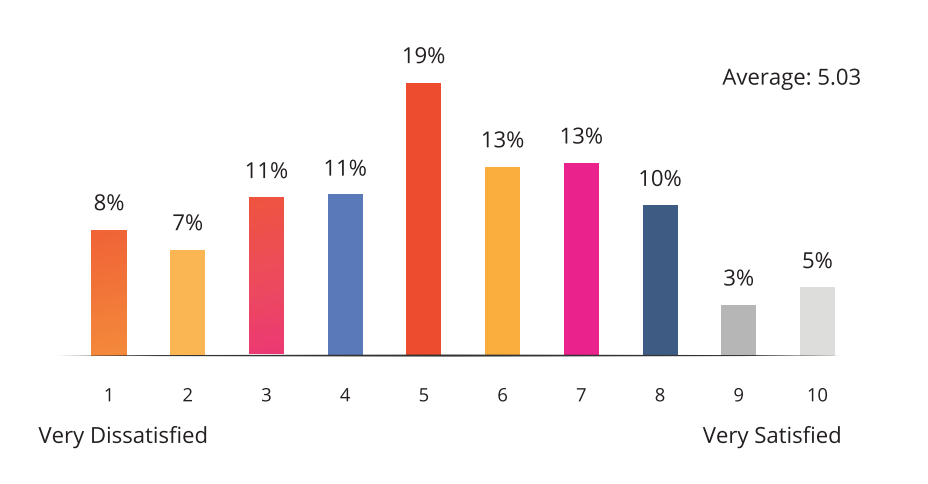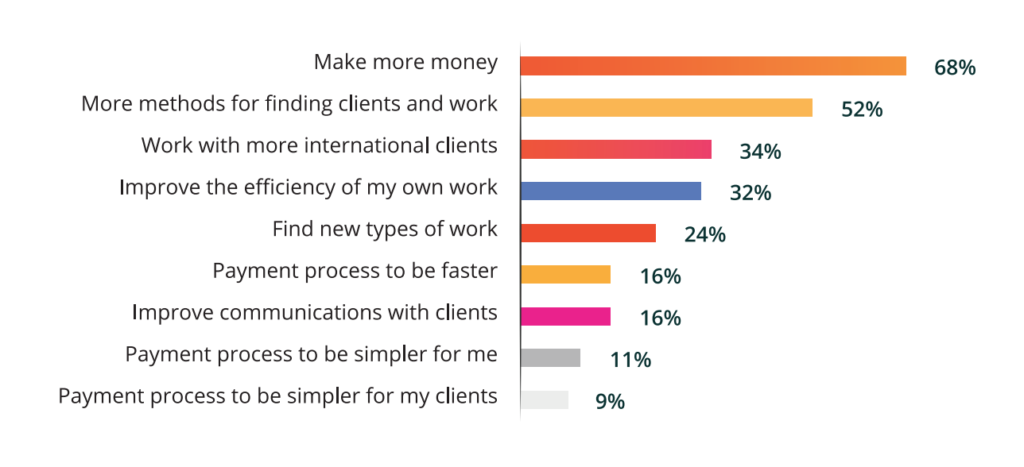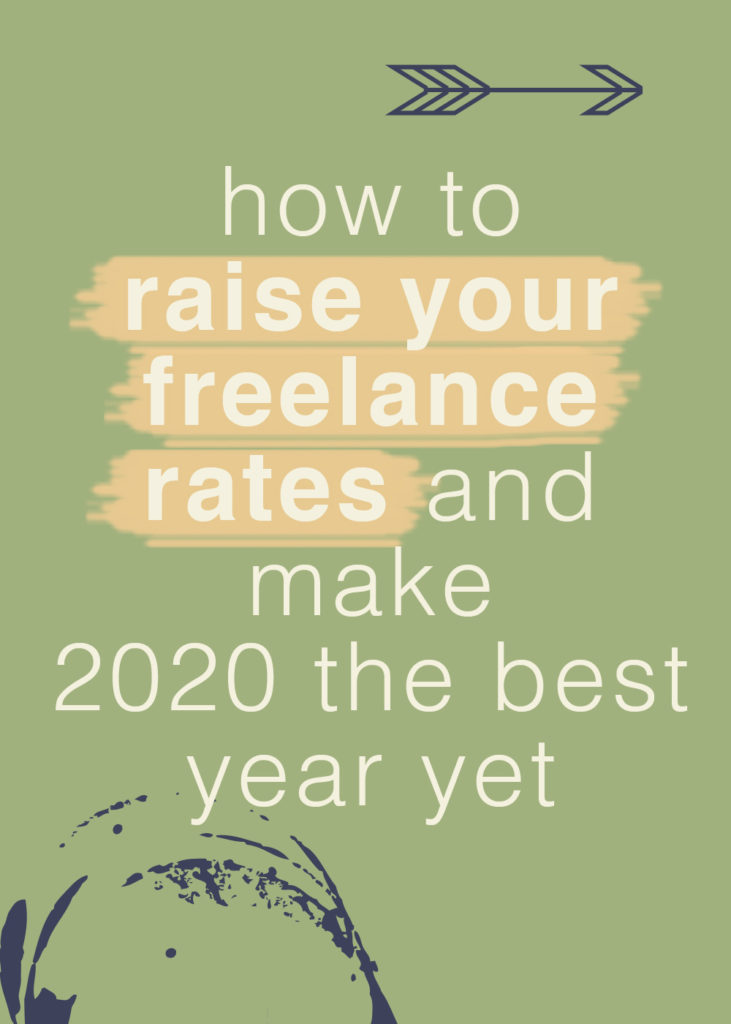If you want to raise your freelance rates, there’s no better time than the start of a new year.
January 1st is always an exciting time.
It brings that heady sense of hope that comes with anything “new” and makes us feel like anything is possible.
But next year isn’t just a new year, it’s a new decade, can you believe it?! We’re heading into 2020 at lightning speed (hello again to the roaring twenties!).
I’m willing to bet you want to make the start of the new decade the best you can, am I right?

Source. Very few freelancers are satisfied with how much they’re paid.
Are You Ready to Raise Your Freelance Rates?
I’m a big advocate of regularly raising your rates if you’re a freelancer.
Full-time employees get pay reviews every year with the potential of a pay rise, so why shouldn’t we? Particularly because we are constantly honing our skills and getting better at what we do.
The freelancer I was four years ago isn’t the freelancer I am today.
I’m much better at what I do, I’ve got a slew of big-name clients under my belt, and I’m considered an expert in my industry.
My prices should reflect that.
There’s no way I should be charging the same freelance rates I was all those years ago because I’m bringing so much more to the table today.
So, if you haven’t raised your rates this year… guess what?
It’s definitely way overdue!
But if the thought of pitching for a pay rise brings you out in a cold sweat, don’t panic! I’ve got a step-by-step guide that will show exactly what you need to do to, first of all, figure out your new rate and, secondly, give you the confidence you need to push for it.

1. Assess Your Skills and Experience
First things first, it’s time to take stock of what you’ve achieved over the past year.
This is a good activity to go through anyway, but it’s particularly helpful if you want to up your rates.
Start by making a note of:
- The clients you’ve worked with over the past year (are there any of note, any particularly big projects, or any that required you to develop and hone new skills?)
- How many projects you’ve worked on and whether there are any that you’re particularly proud of
- How easy it’s been for you to get clients over the past year – if it’s been a breeze, chances are you’re not charging enough!
- How booked up you are into the new year – if you’re booked up, you can afford to charge more!
- Any courses, training, workshops, or other development activities you did
- Any great testimonials or kind words you received from clients over the past 12 months
- Any notable achievements you celebrated either for yourself or for your clients (did you get your own website to the first page of Google? Did you sell out a client’s program in one hour?)
These are all achievements that need to go into your price revisions for the new year.
Listing out everything you’ve done over the year and making a note of how far you’ve come can help put you in the right mindset to up your rates.
You can carry out a bit of research at this point, too: take a look at what other freelancers who offer similar services are charging and check out their experience, client roster, and any achievements they have.
This gives you a good benchmark to start from.
2. Consider Your Percentage Increase
It can be exciting to think about a huge price increase.
People on payroll dream of getting a 20-30% pay rise, but most of the time this just isn’t possible, especially if you’re planning on upping your freelance rates every year (which you should be doing as a freelancer).
While you should take into account everything you’ve achieved over the past year, it can do more harm than good to push for a huge price jump, particularly if you’re main clients are ones you’ve worked with for a long time.
Most of the time, a 5-10% increase is the safe spot.
It’s not too big of a jump for your clients, but can still be a significant increase for you if it’s spread out across all of your client work.
For example, say you have four monthly clients that pay you £500 a month for marketing work. That’s a total of £2,000 a month pre-price increase. If you do a 10% increased for each clients, that’s £50 extra per month, per client, adding an extra £200 to your income.
I successfully raised my rates from .15/word to .20/word for all of my clients. I did this by giving them plenty of advance notice before the increase (1 month) and boosting the value of my services.
I boosted value by including image suggestions, meta descriptions, and title options on all content moving forward. This required very little added work on my end but saved my clients hours of time, so they didn’t even bat an eye at the rate increase! – Makenzi Wood, Freelance Writer
3. Identify Your Lowest Paying Clients and Start There
It can be daunting pushing for a price increase from every single client at the same time. What if none of them are okay with it and you end up losing them all and having no clients?!
It’s a scary thought.
Which is why you should do it strategically and one client at a time – starting with the client that pays you the least.
Craft your first price increase email to them and wait for their response.
You’ll be able to gauge how increasing your rates will go down with other clients from this, but be wary – clients that pay the lowest rates are often the most difficult (I don’t know why, it’s just some weird freelance law) so even if they do react badly, it doesn’t mean your other clients will.
The point is, you can afford to lose your lowest paying client, so that’s where you should start.

Source. A whopping 68% of freelancers want to make more money – one way you can do this is by ditching those low-paying clients.
4. Give Plenty of Time
You don’t want to spring a price increase on your clients overnight as that will put them on the spot and force them into making a rash decision – maybe they need to run it past someone else first, maybe they need to figure out their budget for the next year, and if you’re there saying your rates go up as of next week, they’re going to panic and probably not give you the response you want.
Instead, give them plenty of time.
Ideally, this would be around the three-month mark so they’ve got time to get their ducks in a row and figure out everything else that goes into their budget.
Consider the difference between these two announcements:
- Hey [client], my rates are going up to X as of next week. The next invoice will reflect this increase.
- Hey [client], just a heads up that I’ll be increasing my rates as of 1st Feb 2019 to X. Let me know if you have any questions or would like to discuss further.
The first message is out of the blue and a sure-fire way to send your client into a panic.
The second one includes them in the process and invites them to discuss the situation with you so you can both come out happy at the other end.
5. Don’t Justify Your Decision
Remember, this is your business and you’re in charge of your rates, NOT your clients.
Every business owner has the right to increase their prices at least once a year (we have inflation to thank for that!).
It’s how business works.
Think of all the major businesses out there. Do you think they justify their price increases? You can absolutely bet they don’t.
And neither should you.
Just because you’re a one-person band, doesn’t mean you have to offer a reason for your price increases.
Check out the difference between these two emails:
- Hey [client], I’m increasing my rates to X as of [date] because I’ve done a lot of training over the last year and I think I’m much better at my job now and I’ve worked with loads of clients over the past year.
- Hey [client], just a heads up that I’m increasing my rates to X in line with current inflation levels.
The second email still offers a justification of sorts, but if you feel like you need to mention why in some way, point out that inflation is happening everywhere! It would be stupid not to put your prices up to align with the ballooning price of bread and milk.
6. Add Price Increases to Your Contract Moving Forward
You know what makes it easier to increase your prices? Having a clause in your contract that says you retain the right to reassess your rates every year.
This means that clients literally expect it.
Add something simple to your contracts moving forward, like:
The Freelancer reserves the right to reassess their package prices at least once per year throughout the contract.
Note: I’m categorically not a lawyer, but wording along these lines gets the message across. If you want to make it watertight, consider speaking to a lawyer that can help you get the wording spot on.

7. Quote New Clients Your New Rates
There’s no point increasing your prices with your current roster of clients and then chickening out when it comes to quoting new clients and just giving them your old rates.
The aim is to constantly be increasing your prices, not taking one step forward and two steps back, which means this is a very important part of increasing your prices.
Any new clients that get in touch or reach out to you for your rates get your new prices.
No exceptions.
After a few years, you’ll begin to shed your lowest-paying clients and start building a rock-solid roster of well-paying gigs that continue to bring in more money every year.
Don’t Get Stagnant With Your Pricing
I know freelancers that are five years in and still charging the same rates they did at the start. They’ve hit a ceiling with the amount they can earn and, as a result, their businesses have become stagnant.
There’s no growth because there’s no room for growth.
If you consistently push your prices up, your clients will begin to expect it from you and see it as a totally normal part of working with you. This means you’ll continue to grow your business year after year after year.
So, what will it be?
Will you head into 2020 with the same clients paying the same rates, or will you bite the bullet and start the next decade with a bang (and higher rates)?!






Hey,
You have written very informative article.